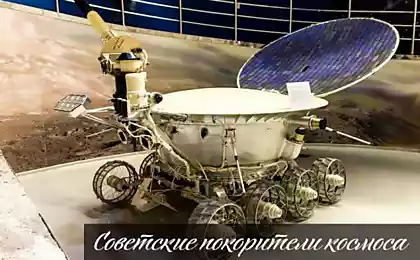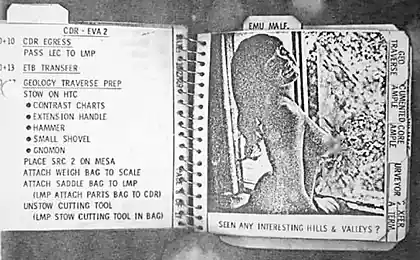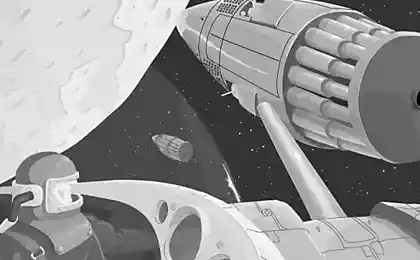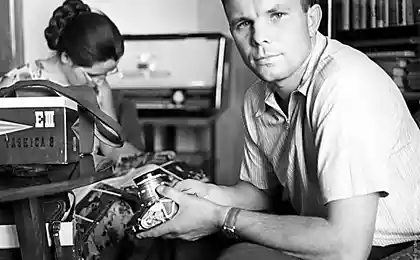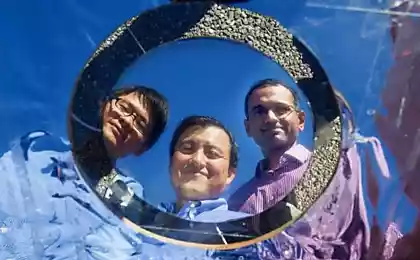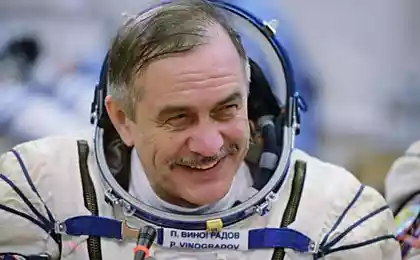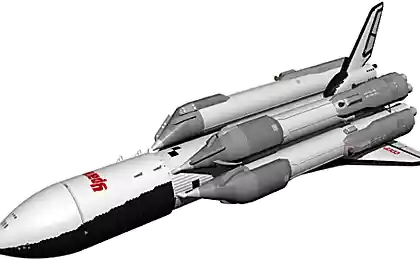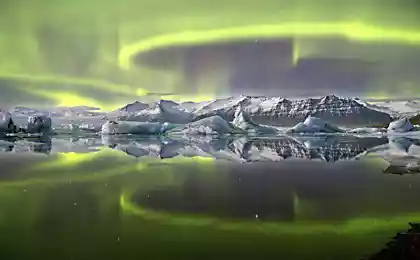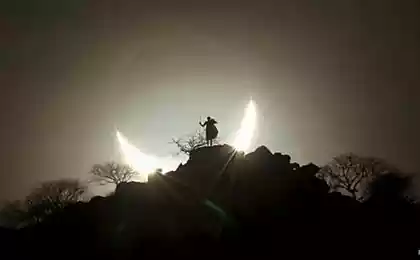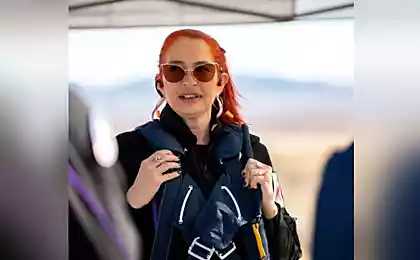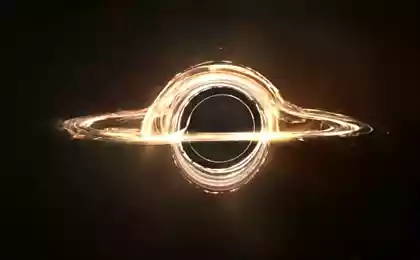783
Kosmos.
I present to you photos and space images of the Earth from space, made last month.
16 photo + letter
1. The glaciers flow down like a river, joined by tributaries, forming large flows. But if the water is flowing, then creeping ice. Susitna Glacier in Alaska went to his long painful journey, when it passed over the NASA satellite "Terra" on 27 August. This image from the satellite combines the infrared, red and green wavelengths to form a color picture unnatural. Vegetation is red, the glacier surface free of dirt sprinkled with blue and dirty brown ice. Impurities relatively pure ice form tributaries to the north. (NASA Earth Observatory)
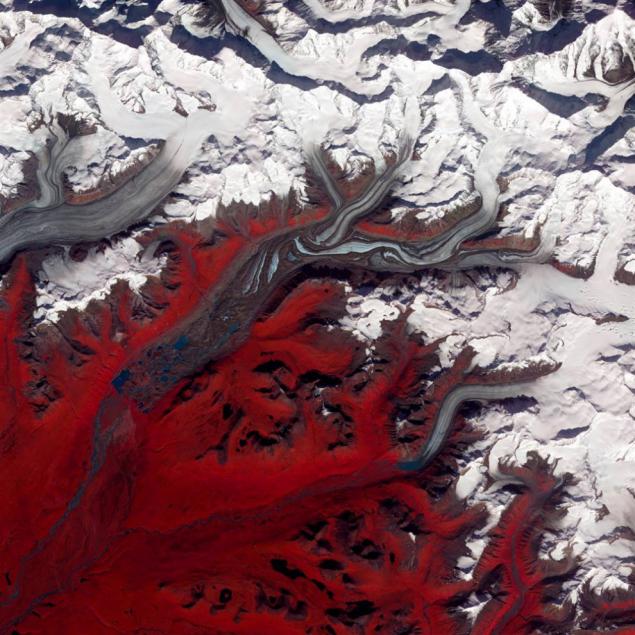
2. In this picture with the navigation camera on NASA's rover «Opportunity» Overlooking the 90 degrees during the day in 2382 the rover on Mars (6 October). The area includes a bright rocks and dark sand ripples inflated by the wind. Destination rover «Opportunity» - the crater Endeavour Crater - is visible on the horizon 8 km. (NASA / JPL-Caltech)

3. rocket plane «SpaceShipTwo» company «Virgin Galactic» for landing aircraft carrier «White Knight Two» during the ceremony of his consecration near Las Cruces, New Mexico, on 22 October. It is planned that the rocket plane «SpaceShipTwo» will take its first passengers on the edge of the open space in a couple of years. (Mark Ralston / AFP - Getty Images)
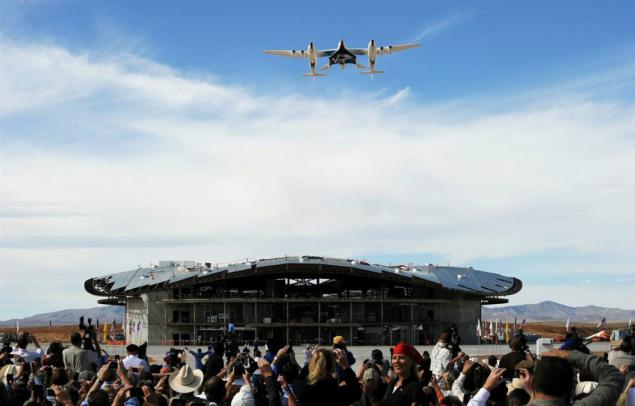
4. In this image, NASA's Solar Dynamics Observatory, made on October 21 shows a sunny spot with flares on the sun. In addition, broad band magnetism cuts through the southern hemisphere of the sun. The band is huge - larger than the distance from the Earth to the Moon. (Solar Dynamics Observatory via NASA)
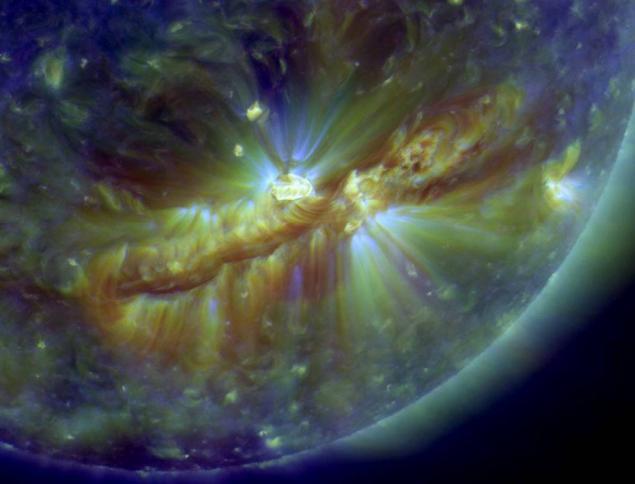
5. This spiral galaxy called NGC 3982 shows a stunning carpet of birth star and stretched "hands". "Hands" are dotted with pink regions of hydrogen streams where star formation, clusters of new stars and dust, which gives the raw material for future stars. The bright nucleus is the older generation of stars. NGC 3982 is located about 68 million light-years away in the constellation Ursa Major. The galaxy extends over a distance of about 30 000 light-years, which is one-third of our Milky Way galaxy. This picture taken by a telescope "Hubble", was published on October 19. (NASA, ESA, and the Hubble Heritage Team (STScI / AURA))
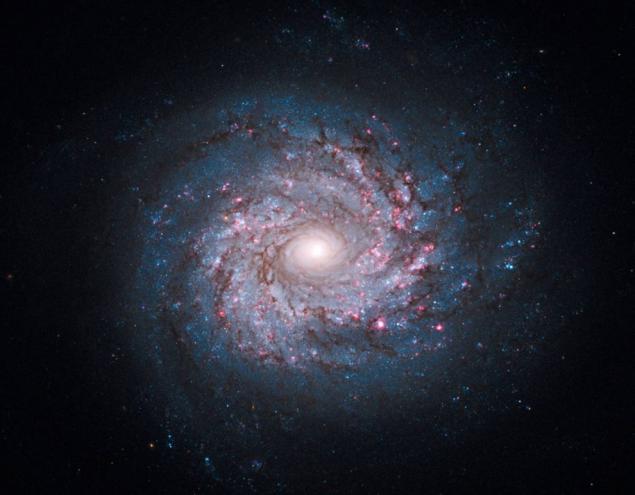
6. This image Mars reconnaissance satellite, on 20 October, shows a bright layered blocks of Martian rock, lying in a dark substance that is likely to remain after a major flood, when Uzboi Valles broke the edge of the crater Holden. On the magnitude of the flood can be judged by the size of large rocks - up to 91 meters in diameter. Holden crater - one of the potential landing site of NASA rover «Curiosity» in November 2011. The geology of this area suggests more humid and warm period in the early history of Mars, so the crater - one of the main objects of study. (NASA / JPL / University of Arizona)

7. An Orthodox priest blesses the launch pad and the spacecraft "Soyuz" October 6, two days before the flight to the International Space Station at Baikonur Cosmodrome. (Dmitry Lovetsky / AFP - Getty Images)
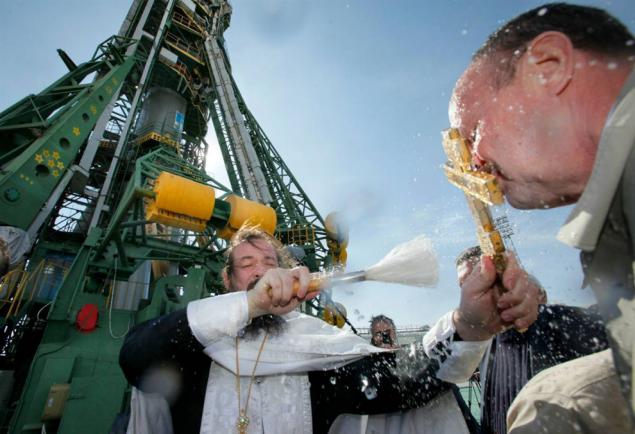
8. In this photo taken telescope "Hubble" and published on October 13, you can see the odd X led trace materials in the form of a comet. Scientists say that the "X" is probably a place of collision of asteroids. 120-meter object in this photo is considered to be remnants of a larger body, faced with stone 3-4 meters in diameter at a speed of 17,702 km / h. The collision happened the explosion force of a small atomic bomb. The astronomer David Jewitt of the University of California said that the collision occurred in February or March 2009. (NASA / ESA / D. Jewitt)

9. This infrared picture, published on October 6 shows a region of star formation at a distance of 2700 light years from Earth. Monoceros R2 - the association of large young stars illuminating a fine collection of reflection nebulae in the large molecular cloud. The picture was taken telescope «VISTA» Observatory in Chile. (ESO / J. Emerson / VISTA. Acknowledgment: Cambridge Astronomical Survey Unit)
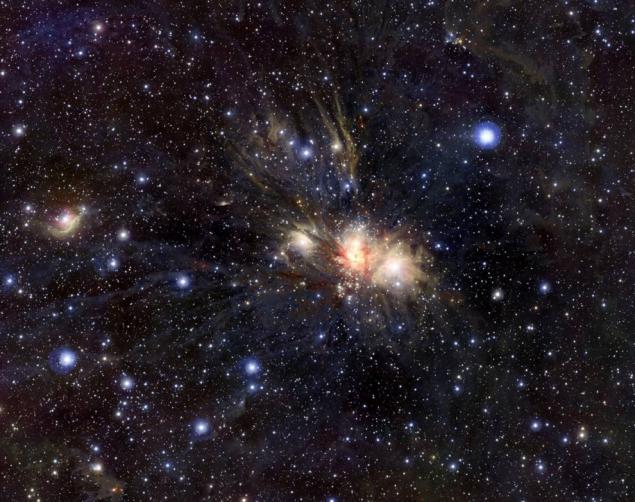
10. Astronav NASA Scott Kelly put his hand through the glass in the hand of his daughter Samantha after the press conference on 6 October at the Russian Baikonur Cosmodrome in Kazakhstan. Kelly had to stay behind glass, as he was quarantined in anticipation of the flight aboard the "Soyuz". Kelly and Russian cosmonauts Alexander and Oleg Skripochka Kaleria started October 8 to the International Space Station. (Shamil Zhumatov / Reuters)
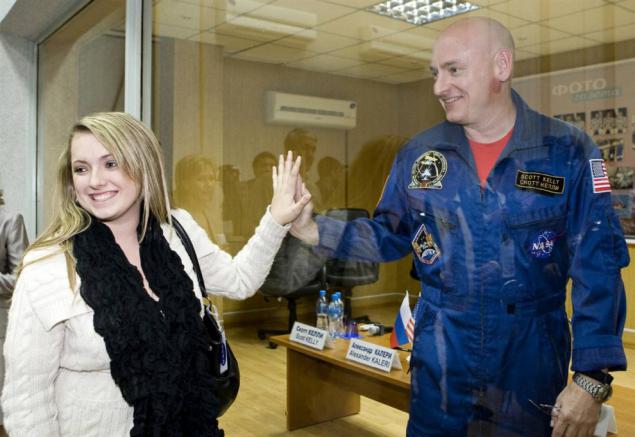
11. October 4 at the factory in Hungary was an accident. Collapsed wall of the waste reservoir, releasing into local rivers, toxic red mud. Several neighboring towns immediately flooded with waste, including Kolontar and Devecser, where in some areas the level of waste reaches two meters. 7 people were killed, dozens of residents were hospitalized with burns. In this photo taken by NASA satellite on October 9 visible red mud flowing from the factory. (NASA Earth Observatory)

12. Launch vehicle "Long March-3C» with Chinese unmanned lunar probe launched from the center in southwest China's Sichuan Province on October 1. (AP)
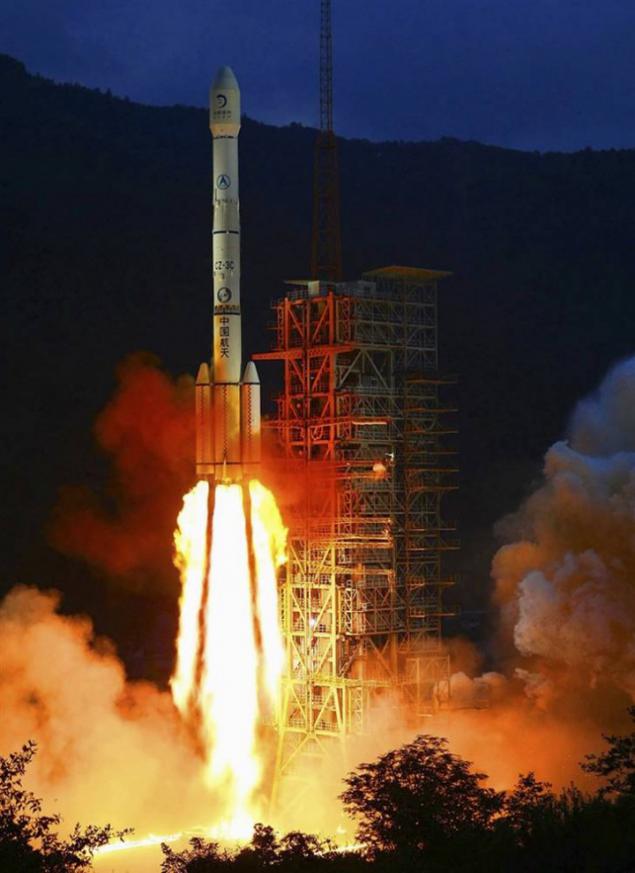
13. In early October, the eastern part of China to establish a high pressure, and air pollution was going there for almost a week. By October 9 and 10 National Environmental Monitoring Centre reported that air was in poor condition around Beijing and in 11 eastern provinces. 32 people were killed in traffic accidents caused by poor visibility. In this photo taken on October 8, the combination of data from NASA satellites "Aqua" and "Terra". (NASA Earth Observatory)
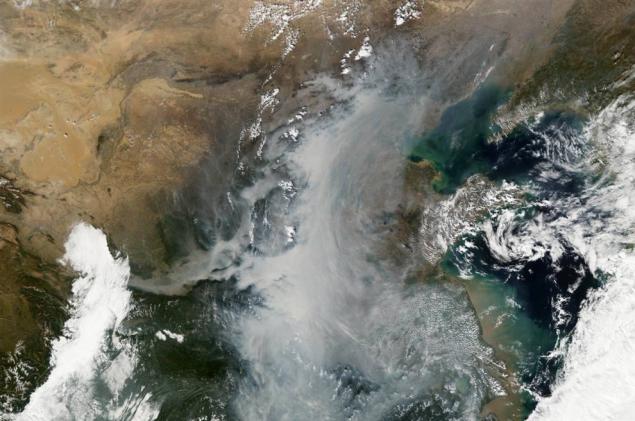
14. Boeing 747 flying to the moon on September 30. Picture taken from Martigues, southern France. (Gerard Julien / AFP - Getty Images)
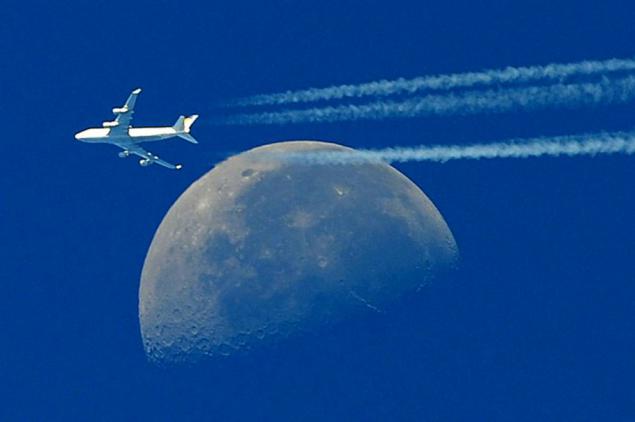
15. Comet Hartley 2 casts a greenish haze of gas and dust red tail, flying 11 million miles from Earth on 20 October. The photo was taken by British astrophotographer Nick Howes. (Nick Howes)
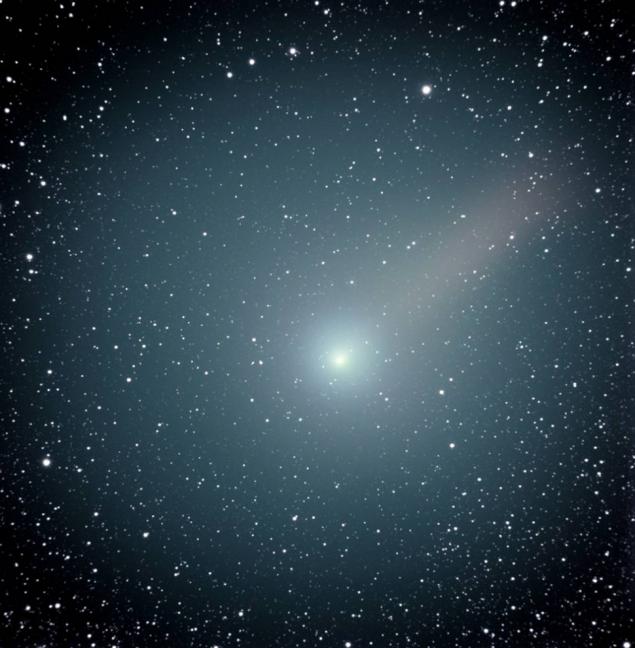
16. In this image, it seems that the International Space Station "sitting" on the Moon, but it actually passes through the lunar disk orbiting the Earth. The photo was taken on October 21 from a small town 120 km west of Budapest. (Bela Vingler / EPA)

Source:
16 photo + letter
1. The glaciers flow down like a river, joined by tributaries, forming large flows. But if the water is flowing, then creeping ice. Susitna Glacier in Alaska went to his long painful journey, when it passed over the NASA satellite "Terra" on 27 August. This image from the satellite combines the infrared, red and green wavelengths to form a color picture unnatural. Vegetation is red, the glacier surface free of dirt sprinkled with blue and dirty brown ice. Impurities relatively pure ice form tributaries to the north. (NASA Earth Observatory)

2. In this picture with the navigation camera on NASA's rover «Opportunity» Overlooking the 90 degrees during the day in 2382 the rover on Mars (6 October). The area includes a bright rocks and dark sand ripples inflated by the wind. Destination rover «Opportunity» - the crater Endeavour Crater - is visible on the horizon 8 km. (NASA / JPL-Caltech)

3. rocket plane «SpaceShipTwo» company «Virgin Galactic» for landing aircraft carrier «White Knight Two» during the ceremony of his consecration near Las Cruces, New Mexico, on 22 October. It is planned that the rocket plane «SpaceShipTwo» will take its first passengers on the edge of the open space in a couple of years. (Mark Ralston / AFP - Getty Images)

4. In this image, NASA's Solar Dynamics Observatory, made on October 21 shows a sunny spot with flares on the sun. In addition, broad band magnetism cuts through the southern hemisphere of the sun. The band is huge - larger than the distance from the Earth to the Moon. (Solar Dynamics Observatory via NASA)

5. This spiral galaxy called NGC 3982 shows a stunning carpet of birth star and stretched "hands". "Hands" are dotted with pink regions of hydrogen streams where star formation, clusters of new stars and dust, which gives the raw material for future stars. The bright nucleus is the older generation of stars. NGC 3982 is located about 68 million light-years away in the constellation Ursa Major. The galaxy extends over a distance of about 30 000 light-years, which is one-third of our Milky Way galaxy. This picture taken by a telescope "Hubble", was published on October 19. (NASA, ESA, and the Hubble Heritage Team (STScI / AURA))

6. This image Mars reconnaissance satellite, on 20 October, shows a bright layered blocks of Martian rock, lying in a dark substance that is likely to remain after a major flood, when Uzboi Valles broke the edge of the crater Holden. On the magnitude of the flood can be judged by the size of large rocks - up to 91 meters in diameter. Holden crater - one of the potential landing site of NASA rover «Curiosity» in November 2011. The geology of this area suggests more humid and warm period in the early history of Mars, so the crater - one of the main objects of study. (NASA / JPL / University of Arizona)

7. An Orthodox priest blesses the launch pad and the spacecraft "Soyuz" October 6, two days before the flight to the International Space Station at Baikonur Cosmodrome. (Dmitry Lovetsky / AFP - Getty Images)

8. In this photo taken telescope "Hubble" and published on October 13, you can see the odd X led trace materials in the form of a comet. Scientists say that the "X" is probably a place of collision of asteroids. 120-meter object in this photo is considered to be remnants of a larger body, faced with stone 3-4 meters in diameter at a speed of 17,702 km / h. The collision happened the explosion force of a small atomic bomb. The astronomer David Jewitt of the University of California said that the collision occurred in February or March 2009. (NASA / ESA / D. Jewitt)

9. This infrared picture, published on October 6 shows a region of star formation at a distance of 2700 light years from Earth. Monoceros R2 - the association of large young stars illuminating a fine collection of reflection nebulae in the large molecular cloud. The picture was taken telescope «VISTA» Observatory in Chile. (ESO / J. Emerson / VISTA. Acknowledgment: Cambridge Astronomical Survey Unit)

10. Astronav NASA Scott Kelly put his hand through the glass in the hand of his daughter Samantha after the press conference on 6 October at the Russian Baikonur Cosmodrome in Kazakhstan. Kelly had to stay behind glass, as he was quarantined in anticipation of the flight aboard the "Soyuz". Kelly and Russian cosmonauts Alexander and Oleg Skripochka Kaleria started October 8 to the International Space Station. (Shamil Zhumatov / Reuters)

11. October 4 at the factory in Hungary was an accident. Collapsed wall of the waste reservoir, releasing into local rivers, toxic red mud. Several neighboring towns immediately flooded with waste, including Kolontar and Devecser, where in some areas the level of waste reaches two meters. 7 people were killed, dozens of residents were hospitalized with burns. In this photo taken by NASA satellite on October 9 visible red mud flowing from the factory. (NASA Earth Observatory)

12. Launch vehicle "Long March-3C» with Chinese unmanned lunar probe launched from the center in southwest China's Sichuan Province on October 1. (AP)

13. In early October, the eastern part of China to establish a high pressure, and air pollution was going there for almost a week. By October 9 and 10 National Environmental Monitoring Centre reported that air was in poor condition around Beijing and in 11 eastern provinces. 32 people were killed in traffic accidents caused by poor visibility. In this photo taken on October 8, the combination of data from NASA satellites "Aqua" and "Terra". (NASA Earth Observatory)

14. Boeing 747 flying to the moon on September 30. Picture taken from Martigues, southern France. (Gerard Julien / AFP - Getty Images)

15. Comet Hartley 2 casts a greenish haze of gas and dust red tail, flying 11 million miles from Earth on 20 October. The photo was taken by British astrophotographer Nick Howes. (Nick Howes)

16. In this image, it seems that the International Space Station "sitting" on the Moon, but it actually passes through the lunar disk orbiting the Earth. The photo was taken on October 21 from a small town 120 km west of Budapest. (Bela Vingler / EPA)

Source:





